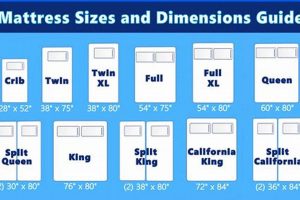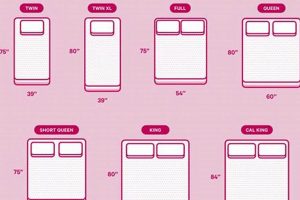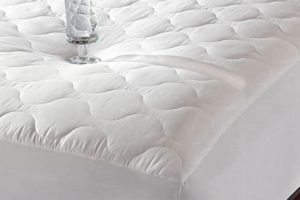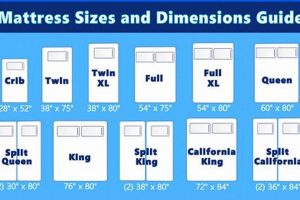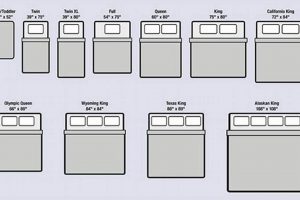A standard toddler bed typically requires a mattress measuring approximately 28 inches wide by 52 inches long. This dimension is specifically designed to fit within the compact frame of toddler beds, offering a secure and comfortable sleeping surface for young children transitioning from a crib. These mattresses are generally thinner than those used for twin or larger beds.
The adoption of this particular size provides a crucial intermediate step for growing children, offering a bed that is more appropriately scaled to their size and developmental needs than a full-sized bed. This transition promotes a sense of security and independence. Historically, this standardized size allows for compatibility across a variety of toddler bed frames, ensuring that parents can easily find a suitable mattress regardless of the bed’s manufacturer.
Understanding the standard dimensions of toddler mattresses is essential when selecting bedding and creating a safe and comfortable sleep environment. The following sections will delve deeper into material options, safety considerations, and factors to consider when choosing the right mattress for a toddler.
Tips for Selecting a Toddler Mattress
Choosing the correct size is fundamental to ensuring the safety and comfort of a toddler. These tips provide guidance on selecting an appropriately sized mattress.
Tip 1: Measure the Bed Frame Interior. Before purchasing, precisely measure the interior dimensions of the toddler bed frame. These measurements should align closely with the standard toddler mattress size (approximately 28 inches by 52 inches) to prevent gaps or overcrowding.
Tip 2: Verify Standard Dimensions. Although 28 inches by 52 inches is the standard, slight variations may exist between manufacturers. Confirm the stated dimensions before purchase to avoid compatibility issues. Checking reviews can give an indication of accuracy.
Tip 3: Prioritize a Snug Fit. The mattress should fit snugly within the frame. Gaps exceeding one inch on any side pose a safety risk, potentially leading to entrapment.
Tip 4: Inspect for Proper Support. A mattress of appropriate dimensions must also provide adequate support. Test the firmness of the mattress to ensure it is neither too soft (creating a suffocation hazard) nor too hard (compromising comfort).
Tip 5: Consider Mattress Thickness. While length and width are critical, thickness also impacts the overall fit. A mattress that is too thick can raise the sleep surface above the safety rails, increasing the risk of falls.
Tip 6: Review Safety Certifications. Ensure the mattress carries relevant safety certifications, indicating it meets standards for flammability, chemical emissions, and overall product safety. Certifications such as GREENGUARD Gold are beneficial.
Tip 7: Check Mattress Weight Limit. Confirm that the toddler mattress can support the weight of the child. Overloading the mattress can affect its performance and longevity. Typically, toddler beds and mattresses will have a weight limit clearly stated.
Selecting a correctly sized toddler mattress, paired with appropriate safety checks, directly contributes to a secure and comfortable sleep environment for the child. Adhering to these guidelines minimizes risks and maximizes the benefits of transitioning to a toddler bed.
The next section will cover the different types of materials that toddler mattresses are made of and what to look for.
1. Standard Dimensions
The term “Standard Dimensions” directly correlates to “what size is a toddler mattress,” referring to the generally accepted measurements that define a toddler mattress. These dimensions are designed to ensure compatibility with toddler beds and to provide a safe and comfortable sleeping surface for young children transitioning from a crib.
- Defined Measurements
The standard size of a toddler mattress is approximately 28 inches wide by 52 inches long. These specific measurements facilitate a snug fit within the majority of toddler bed frames available on the market. Deviations from these dimensions can lead to safety concerns, such as gaps between the mattress and the frame where a child could become entrapped.
- Frame Compatibility
Adherence to standard dimensions ensures that the mattress will fit appropriately within the toddler bed frame. This compatibility is crucial because it allows for the secure placement of the mattress, preventing movement or shifting during use. Incompatible dimensions could result in an unstable sleep environment, increasing the risk of accidents.
- Safety Considerations
The standardized size supports safety measures implemented by manufacturers. When a mattress conforms to these dimensions, it is more likely to work correctly with safety features like side rails, which are designed to prevent falls. Non-standard sizes might render these safety features ineffective.
- Industry Standards
The uniformity in size allows for the consistent application of industry safety standards and testing protocols. Manufacturers design and test their products based on these common dimensions, ensuring that the mattresses meet or exceed safety regulations. This uniformity streamlines the production and certification processes.
In summary, the “Standard Dimensions” of a toddler mattress are integral to its functionality and safety. These dimensions directly impact the mattress’s ability to fit correctly within a toddler bed frame, provide adequate support, and work in conjunction with safety features. Consistency in size facilitates adherence to industry standards, contributing to a safer sleep environment for toddlers. Deviation from these standard measurements introduces potential hazards and undermines the intended benefits of a toddler mattress.
2. Frame Compatibility
Frame compatibility is inextricably linked to the dimensions of a toddler mattress. The primary function of a toddler bed frame is to securely contain the mattress, preventing movement and ensuring child safety. Therefore, a mattress designed to the incorrect dimensions, deviating from the standard approximately 28 inches by 52 inches, renders the frame functionally useless. Consider a scenario where a mattress is significantly smaller than the frame; this creates dangerous gaps where a child’s limbs could become trapped, potentially leading to injury. Conversely, a mattress that is too large may not fit within the frame at all, or it could compromise the structural integrity of the bed.
The practical significance of understanding frame compatibility extends beyond simply fitting the mattress. It directly impacts the effectiveness of safety features. For instance, side rails are designed to prevent falls, but their effectiveness is contingent upon the mattress being flush with the frame. A poorly fitting mattress undermines the protective function of these rails. Similarly, the longevity of both the mattress and the frame is affected by compatibility. A mattress under constant pressure due to being too large for the frame may degrade more rapidly. A frame subjected to undue stress from an oversized mattress may also be prone to damage.
In summary, frame compatibility is not merely a matter of convenience but a critical safety consideration intertwined with mattress dimensions. While selecting a toddler mattress, adherence to standard sizing is paramount to ensuring a secure and stable sleep environment. The consequences of neglecting this aspect range from discomfort to potential physical harm. Therefore, prioritizing frame compatibility, by verifying mattress dimensions and assessing frame integrity, is essential for caregivers.
3. Thickness Variance
Thickness variance in toddler mattresses is not merely a matter of preference but a critical safety and functional consideration intimately linked to the overall dimensions and suitability of “what size is a toddler mattress” for its intended bed frame. Different thicknesses affect the sleep surface height, support, and the effectiveness of safety features, all impacting a toddler’s sleep environment.
- Impact on Safety Rail Height
The thickness of the mattress directly influences the effectiveness of safety rails on a toddler bed. A mattress that is too thick raises the sleeping surface, reducing the protective height of the side rails and increasing the risk of a child falling out of bed. Conversely, a mattress that is too thin might not adequately fill the space, potentially leading to a gap between the mattress and rails where a child could become entrapped. A thickness variance beyond the frame’s design parameters can compromise safety standards.
- Effect on Support and Comfort
Thickness contributes to the overall support and comfort level of the mattress. Thicker mattresses may offer more cushioning and better weight distribution, which can be beneficial for a growing child’s spine. However, excessive thickness could lead to a sleeping surface that is too soft, posing a suffocation risk. The optimal thickness variance should balance support and comfort, adhering to safety guidelines regarding firmness. For example, a mattress of appropriate thickness provides adequate support, preventing the child from sinking too deeply into the material, which is especially vital for younger toddlers.
- Compatibility with Bed Frame Structure
The chosen thickness must align with the structural design of the toddler bed frame. Frames are typically designed to accommodate mattresses within a specific thickness range. Using a mattress that deviates significantly from this range can strain the frame’s structural integrity, potentially causing damage or instability. Furthermore, if the thickness is not considered, the mattress may not sit properly on the supporting slats or base, affecting its overall performance and longevity. Consideration of thickness variances is crucial for maintaining the intended functionality of the bed frame.
- Compliance with Safety Standards
Regulatory bodies often specify thickness parameters as part of safety standards for toddler mattresses. These standards are in place to minimize risks associated with suffocation, entrapment, and falls. A mattress with significant thickness variance may not meet these standards, potentially exposing children to unsafe sleeping conditions. Verification of compliance with relevant safety certifications, such as those related to flammability and chemical emissions, is essential when assessing thickness. Choosing a mattress that meets these standards ensures adherence to established safety protocols.
Understanding the implications of thickness variance in relation to the overall dimensions is pivotal in ensuring the safety, comfort, and suitability of a toddler mattress. Consideration of these factors, in conjunction with frame compatibility and adherence to safety standards, contributes to a secure and supportive sleep environment for toddlers.
4. Support Needs
Support needs, specifically in relation to toddler mattresses, directly correlate to proper spinal alignment and healthy development. A mattress of inappropriate dimensions can compromise necessary support, impacting a toddler’s posture and sleep quality. Therefore, understanding these support needs is vital when considering the correct mattress size.
- Spinal Alignment
A properly sized toddler mattress must facilitate correct spinal alignment during sleep. If the mattress is too soft or lacks adequate support, the spine may sag, leading to discomfort or developmental issues. A mattress measuring approximately 28 inches by 52 inches, with appropriate firmness, is generally recommended to maintain proper spinal curvature. Without this support, toddlers are at risk of developing poor sleeping posture that could have long-term skeletal implications. Examples include mattresses that are so soft the toddler ‘sinks’ into them, or those that have uneven distribution of material leading to one section being softer than another.
- Weight Distribution
The dimensions of a toddler mattress affect the distribution of a child’s weight across the sleeping surface. If the mattress is inadequately sized or lacks sufficient internal support, weight may not be evenly distributed, creating pressure points. For example, in a too-small mattress, the toddler might be forced into a fetal position, or might be unable to fully extend, impacting pressure distribution and sleep quality. A mattress with balanced support alleviates pressure points and promotes better blood circulation, enhancing sleep quality. A larger toddler mattress might not fit well onto the toddler bed, resulting in uneven support and potential for it to be unstable.
- Firmness Considerations
Firmness is a crucial component of support needs. A toddler mattress should neither be too firm nor too soft. An overly soft mattress can pose a suffocation hazard and may not provide adequate spinal support, whereas an overly firm mattress can cause discomfort. The optimal firmness is contingent upon the childs weight and developmental stage. Toddlers transitioning from cribs need a firmer surface compared to older children. Standard-sized mattresses generally comply with firmness safety regulations. A toddler mattress, measuring the standard 28×52, often comes with adequate firmness levels, meeting this essential support need
- Material Composition
The internal composition of a toddler mattress significantly impacts its support capabilities. Mattresses constructed of high-density foam or innerspring systems tend to offer more robust support compared to those made of low-density materials. The materials and construction affect the support the mattress provides while conforming to the standard dimensions of a toddler bed. The quality and type of material are therefore important in relation to “what size is a toddler mattress”.
The interplay between spinal alignment, weight distribution, firmness, and material composition underscores the importance of choosing a toddler mattress that meets specific support needs. Selecting a mattress of appropriate size and construction is essential to foster healthy development and ensure restful sleep. Ultimately, “what size is a toddler mattress” plays a pivotal role in providing adequate support, thereby impacting the overall well-being of the child. Ignoring support needs when selecting a toddler mattress can lead to significant health and developmental consequences, highlighting the need for careful consideration.
5. Safety Standards
Adherence to established safety standards is paramount in the design and manufacturing of toddler mattresses. These standards are directly related to “what size is a toddler mattress” as the dimensions influence overall product safety and performance. Strict guidelines regulate materials, construction, and testing procedures to minimize potential hazards to young children.
- Flammability Regulations
Flammability regulations mandate that all mattresses, including those designated for toddlers, meet specific fire resistance requirements. These regulations, such as those outlined in 16 CFR Part 1633, necessitate the use of materials and construction techniques that delay or prevent the spread of fire. “What size is a toddler mattress” is a factor because the surface area and volume of the mattress influence how quickly a fire might spread. Smaller mattresses, such as toddler mattresses, must still meet the same rigorous flammability standards as larger mattresses, ensuring a consistent level of fire safety regardless of size. Non-compliance with flammability standards can lead to rapid fire spread and increased risk of injury in the event of a fire.
- Chemical Emissions Standards
Chemical emissions standards, such as those defined by GREENGUARD Gold certification, limit the amount of volatile organic compounds (VOCs) released from mattresses. These VOCs can contribute to indoor air pollution and may pose health risks, particularly for vulnerable populations like toddlers. These standards are relevant to “what size is a toddler mattress” because even smaller mattresses can emit harmful chemicals. The GREENGUARD Gold certification tests mattresses for over 10,000 chemicals and VOCs, ensuring that they meet stringent emissions standards. Compliance with these standards minimizes exposure to potentially harmful substances and promotes a healthier sleep environment. The standard-sized toddler mattress is often tested and certified to meet such guidelines.
- Physical Hazard Requirements
Physical hazard requirements address design and construction aspects that could pose risks of entrapment, suffocation, or injury. These requirements dictate that mattresses must fit snugly within toddler bed frames to prevent gaps where a child could become trapped. The precise dimensions related to “what size is a toddler mattress” are crucial for ensuring this snug fit. For example, a mattress that deviates from the standard dimensions of approximately 28 inches by 52 inches could create dangerous gaps, increasing the risk of entrapment. Additionally, firmness standards are in place to prevent suffocation hazards. These physical hazard requirements minimize risks associated with the physical characteristics of the mattress. Testing includes assessments of edges, corners, and overall structural integrity.
- Labeling and Information Requirements
Labeling and information requirements mandate that manufacturers provide clear and accurate information about the mattress, including its dimensions, materials, care instructions, and safety certifications. This information allows consumers to make informed decisions and use the mattress safely. The label would clearly state the dimensions related to “what size is a toddler mattress”. Providing accurate information about the mattress’s compliance with safety standards is essential for ensuring consumer awareness and proper use. Misleading or incomplete labeling can undermine safety efforts and expose children to unnecessary risks. Examples of required information include flammability warnings, chemical emissions certifications, and care instructions.
These interlinked safety standards emphasize the criticality of adhering to dimensional specifications in manufacturing toddler mattresses. Maintaining compliance across flammability, chemical emissions, physical hazard, and labeling requirements helps mitigate potential risks and fosters a secure sleep environment for toddlers. When selecting a toddler mattress, it is crucial to verify compliance with these safety standards to ensure the child’s health and well-being. The adherence to size and materials leads to the reduction in hazardous incidents. Ultimately, the appropriate selection depends on the dimension, material and overall structural integrity.
6. Weight Capacity
Weight capacity is an important consideration inextricably linked to the dimensions of a toddler mattress. “What size is a toddler mattress”, generally approximately 28 inches by 52 inches, will, by definition, support a limited weight range dictated by its internal structure and materials. Exceeding this designated weight capacity can lead to mattress deformation, reduced support, and potential safety hazards. A toddler mattress too small for a larger child, even if that child is still technically a toddler by age, might compromise the structural integrity of the mattress leading to uneven sleeping surface and increasing risk of falls.
Understanding the weight capacity of a toddler mattress is not merely an academic exercise but a practical necessity. The primary reason is maintaining the intended level of support and comfort. A mattress designed to support, for example, up to 50 pounds will not adequately support a child weighing 60 pounds. This mismatch leads to sagging, uneven weight distribution, and reduced spinal support. More importantly, it affects the mattress’s safety features. For example, if a mattress deforms significantly under excess weight, it may no longer properly fit within the bed frame, potentially creating entrapment hazards. For instance, a toddler mattress rated for 40 pounds, being used for a 55-pound child, could compress excessively, lowering the side rail height and increasing the risk of the child rolling out of the bed. The specified dimensions are crucial because it determines the surface area distributing the support. If the toddler is heavier, the smaller mattress size may not be adequate for support and comfort.
In summation, weight capacity and size (“what size is a toddler mattress”) are interwoven parameters in maintaining safety and performance. Ignoring the weight restrictions risks not only reducing mattress lifespan but also compromising the child’s comfort, safety and the long-term integrity of the mattress, leading to the lack of safety adherence. Adhering to weight limitations of appropriately sized mattresses guarantees safety. Therefore, responsible selection considers both factors – ensuring alignment to both safety and dimension is vital for providing a secure, comfortable, and structurally sound sleep environment.
Frequently Asked Questions
This section addresses common inquiries regarding the appropriate dimensions and related considerations for toddler mattresses. The information presented aims to provide clarity and guidance for parents and caregivers seeking to ensure a safe and comfortable sleep environment for their toddlers.
Question 1: What is the standard size for a toddler mattress?
A standard toddler mattress typically measures approximately 28 inches in width and 52 inches in length. This dimension is designed to fit within the frame of a standard toddler bed.
Question 2: Are toddler mattresses the same size as crib mattresses?
While there can be overlap, many crib mattresses share those same dimensions, it’s crucial to verify prior to making a purchase. Many full-sized cribs use the standard toddler mattress dimensions, but mini-cribs do not.
Question 3: Can a twin-size mattress be used in a toddler bed?
A twin-size mattress cannot be used in a toddler bed due to its significantly larger dimensions. A twin mattress typically measures approximately 39 inches wide by 75 inches long, which is substantially larger than the standard toddler mattress size.
Question 4: What should be considered when choosing the thickness of a toddler mattress?
The thickness of the mattress should be considered in relation to the height of the toddler bed’s safety rails. A mattress that is too thick may reduce the effectiveness of the safety rails, while one that is too thin may create gaps and pose a safety hazard. Check manufacturer specifications.
Question 5: Are there specific safety certifications to look for when purchasing a toddler mattress?
It is advisable to look for certifications such as GREENGUARD Gold, which indicates that the mattress has been tested for chemical emissions. Compliance with federal flammability standards is also essential.
Question 6: How does the weight capacity of a toddler mattress relate to its size?
The weight capacity of a toddler mattress is determined by its construction and materials. While the size provides a general guideline, exceeding the specified weight limit can compromise the mattress’s support and longevity, regardless of its dimensions.
In summary, selecting a toddler mattress requires careful consideration of its dimensions, thickness, safety certifications, and weight capacity. Adhering to these guidelines ensures a safe and comfortable sleep environment for the child.
The subsequent section will discuss specific mattress material options appropriate for toddlers.
Toddler Mattress Dimensions
The preceding sections have comprehensively explored “what size is a toddler mattress,” detailing the standardized dimensions and their implications for safety, support, and frame compatibility. Emphasis has been placed on the importance of adhering to these specifications to prevent potential hazards and facilitate optimal development during a crucial stage of a childs life. Considerations extend beyond mere measurements, encompassing thickness variance, material composition, and adherence to stringent safety standards. The review of common queries further reinforces the necessity for informed decision-making.
Selecting a toddler mattress is not merely a purchasing decision but an investment in a child’s well-being. Diligence in confirming appropriate dimensions and scrutinizing safety certifications is paramount. Prioritizing these factors creates a secure foundation for healthy sleep habits and reduces the risk of accidents. The informed selection process, guided by reliable information and adherence to safety guidelines, ultimately contributes to a nurturing and secure environment for a child’s formative years.


